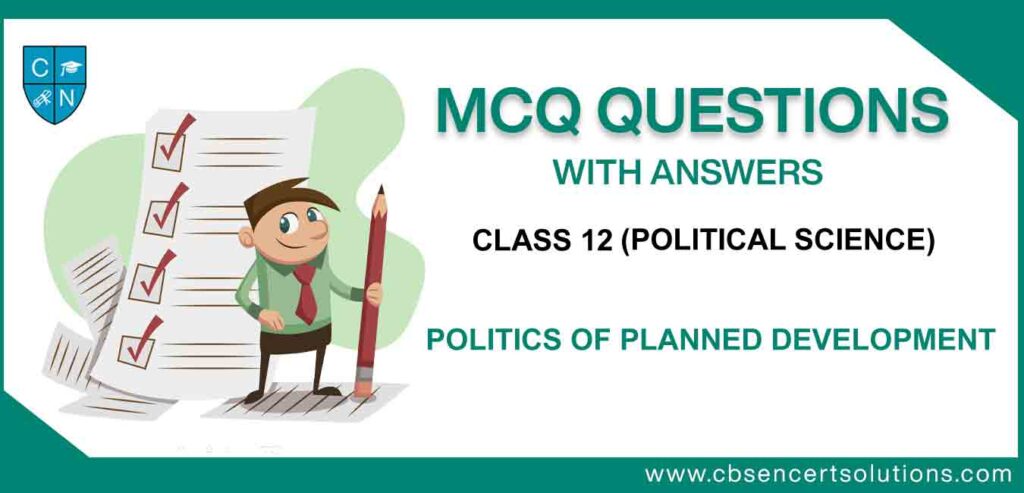Check the below NCERT MCQ Class 12 Political Science Chapter 3 Politics of Planned Development with Answers available with PDF free download. MCQ Questions for Class 12 Political Science with Answers were prepared based on the latest syllabus and examination pattern issued by CBSE, NCERT and KVS. Our teachers have provided below Politics of Planned Development Class 12 Political Science MCQs Questions with answers which will help students to revise and get more marks in exams
Politics of Planned Development Class 12 Political Science MCQs Questions with Answers
Refer below for MCQ Class 12 Political Science Chapter 3 Politics of Planned Development with solutions. Solve questions and compare with the answers provided below
Question. …………………. was also associated with the ideas of growth, material progress and scientific rationality.
(A) Democracy
(B) Secularism
(C) Globalization
(D) Modernization
Answer
D
Question. Which apex body is responsible for decision making and deliberations on development matters in India?
(A) Finance Ministry
(B) Niti Ayog
(C) The National Development Council
(D) None of the above
Answer
C
Question. Which of these statements about the Bombay Plan is incorrect?
(A) It was a blueprint for India’s economic future.
(B) It supported state-ownership of industry.
(C) It was made by some leading industrialists.
(D) It supported strongly the idea of planning.
Answer
A
Question. Which factor was responsible for discouraging research and development in manufacturing sector?
(A) Goods manufactured by local industries
(B) Poor import and export policy
(C) Export restrictions on goods manufactured in India
(D) All of the above
Answer
C
Question. In 1946, who was chairman of the Planning Advisory Board?
(A) K C Neogy
(B) Sardar Patel
(C) Dr. Ambedkar
(D) None of the above
Answer
A
Question. Which one of the following was not a part of the early phase of India’s development policy?
(A) Planning
(B) Self sufficiency
(C) Privatization
(D) Social and economic justice.
Answer
C
Question. Why were the tribal hostile to the development of Odisha?
(A) They feared loss of their employment as well as lodgings
(B) They were illiterate
(C) They never liked intrusion of outsiders
(D) All of the above
Answer
A
Question. On which model was The Planning Commission of India setup?
(A) Calcutta model
(B) Bombay Plan
(C) National Development Model
(D) None of the above
Answer
B
Question. What was the concept of becoming more ‘modern’?
(A) Industrialized countries in West
(B) Developing like an own identity of developed nation
(C) Adopting globalization to a higher extent
(D) Adopting western capitalist modal of economy
Answer
A
Question. NITI Aayog was set up:
(A) to bring more accuracy in the development
(B) because people had expectations for growth and development in the administration through their participation
(C) so that departments could be included in Planning Commission
(D) all the above
Answer
B
Question. Why J. C. Kumarappa supported the plan of industrialization of rural areas?
(A) For the ground level development
(B) To help the poor
(C) To escape the vicious circle of poverty
(D) To boost up the economy
Answer
C
Question. When the NDC was setup?
(A) 6 August 1952
(B) 6 December 1952
(C) 7 August 1952
(D) 10 June 1952
Answer
A
Question. The principle of land reforms failed across the country:
(A) due to the government policies
(B) due to recession all over the country
(C) because nobody was capable of buying the land
(D) due to political influence and corruption in the society
Answer
D
Question. …………………. Policy has been adopted by NITI Aayog.
(A) Make in India
(B) Come on India
(C) Start-up India
(D) Swachch Bharat
Answer
A
Question. Identify the stages of modernization:
(A) Agrarian society
(B) Drive to maturity
(C) Age of high consumption
(D) All of the Above
Answer
D
Question. When were the restrictions on private industries imposed?
(A) 1960s
(B) 1970s
(C) 1990s
(D) 1950s
Answer
A
Question. The idea of planning in India was drawn from:
(i) the Bombay Plan
(ii) experiences of the Soviet bloc countries
(iii) Gandhian vision of society
(iv) demand by peasant organisations
(A) (ii) and (iv) only
(B) (iii) and (iv) only
(C) (i) and (ii) only
(D) All of the above
Answer
D
Question. …………………. play an important role in the economy of developing countries like India.
(A) Private sectors
(B) Public sectors
(C) Union ministers
(D) State government
Answer
B
Question. …………………. acts as a think tank of the Union Government.
(A) NITI Aayog
(B) Yojana Aayog
(C) Election Commission of India
(D) Ministry of External Affairs
Answer
A
Question. White revolution is related to __?
(a) By increasing the yield of wheat
(b) Dairy Program
(c) Fishing
(d) silkworm
Answer
B
Question. Who was the first Deputy Chairman of NITI Aayog ?
(a) Amitabh Kant
(b) Rajeev Kumar
(c) Arvind Panagariya
(d) Narendra Modi
Answer
C
Question. When was the National Development Council established ?
(a) 1920
(b) 1950
(c) 1952
(d) 2015
Answer
C
Question. The second five year plan was drafted under the leadership of ______
(a) N. Roy
(b) N. Raj
(c) P.C. Mahalanobis
(d) C. Kumar
Answer
C
Question.When was the NITI Commission established?
(a) 1st March, 2015
(b) 1st January, 2015
(c) 1st April, 2015
(d) 1st March, 1950
Answer
B
Question.At present, which institution is performing the work of planning in our country?
(a) Planning Commission
(b) Economic Commission
(c) Union Public Service Commission
(d) NITI Commission (Aayog)
Answer
D
Assertion (A) is followed by a statement of Reason (R). Mark the correct choice as:
(A) Both (A) and (R) are true, but (R) is the correct explanation of (A).
(B) Both (A) and (R) are true, but (R) is not the correct explanation of (A).
(C) (A) is true, but (R) is false.
(D) (A) is false, but (R) is true.
Question. Assertion: The draft of the First Five Year Plan and then the actual Plan Document, released in December 1951, generated a lot of excitement in the country.
Reason: This draft failed to meet the expectations of the country as it did not have anything for common men.
Answer
C
Question. Assertion: The First Five Year Plan (1951–1956) sought to get the country’s economy out of the cycle of poverty.
Reason: K. N. Raj, a young economist involved in drafting the plan, argued that India should ‘hasten slowly’ for the first two decades as a fast rate of development might endanger democracy.
Answer
B
Question. Assertion: The example of Orissa shows us that it is not enough to say that everyone wants development.
Reason: For ‘development’ has same or similar meanings for different sections of the people.
Answer
C
Question. Assertion: The excitement with planning reached its peak with the launching of the Second Five Year Plan in 1956 and continued somewhat till the Third Five Year Plan in 1961.
Reason: Though many criticisms emerged both about the process and the priorities of these plans, the foundation of India’s economic development was firmly in place by then.
Answer
A
Question. Assertion: India did not follow any of the two known paths to development – it did not accept the capitalist model of development in which development was left entirely to the private sector, nor did it follow the socialist model in which private property was abolished and all the production was controlled by the state.
Reason: It was India’s one of the biggest mistakes that India did not adopt any one of the two models suggested above.
Answer
B
Question. Assertion: The nationalist leaders were clear that the economic concerns of the government of free India would have to be different from the narrowly defined commercial functions of the colonial government.
Reason: It was further clear that the eradication of the poverty was not the responsibility of the government, but the people.
Answer
C
Question. Assertion: Development could not be left to private actors, that there was the need for the government to develop a design or plan for development.
Reason: The Bombay Plan wanted the state to take major initiatives in industrial and other economic investments.
Answer
B
Question. Assertion: The Second Five Year Plan stressed on heavy industries. It was drafted by a team of economists and planners under the leadership of P. C. Mahalanobis.
Reason: However, the Second Five Year Plan was responsible for the ruin of the agriculture as it did not have enough funding to support it.
Answer
C
Question. Assertion: ‘Development’ was about becoming more ‘modern’ and modern was about becoming more like the industrialized countries of the West.
Reason: It was believed that every country would go through the process of modernization as in the West, which involved the breakdown of traditional social structures and the rise of capitalism and liberalism.
Answer
A
Question. Assertion: Huge allocations were made for largescale projects like the Bhakhra Nangal Dam.
Reason: Agricultural sector was hit hardest by Partition and needed urgent attention.
Answer
A

We hope you liked MCQ Class 12 Political Science Chapter 3 Politics of Planned Development with answers provided above. Incase you have any questions please post them in the comments section below and our Political Science teachers will provide a response.
